|
12. Conductivity probe
Conductivity tester is a simple,
but very important instrument, which is able to test for faults many
components like: diodes, transistors, coils, transformers, speakers and
headphones, capacitors, switches, jumpers, cables and many other
different electronic components. This method is a lot faster and
straightforward than it is using some “off the shelf” instrument.
Schematic for this device is on 12.1a. It is called a relaxation audio
oscillator. When you connect points A and B using a piece of copper
wire, a variable current flows through the transistors as sequences of
impulses. This means that immediately upon connecting the points A and
B, current level rapidly rises to some destined maximum value, and then
drops to zero. For certain amount of time there is no current, after
which it rises again rapidly, and whole cycle repeats itself. Since
relation of times when current is flowing and when it is not is highly
in favor of the later, this kind of current is called the spike impulse
current. Collector current of a T2 transistor flows through the speaker
which generates sound, whose base frequency could be calculated using
this approximate equation.

In our case R=47 kOhm and C=47 nF, which means:

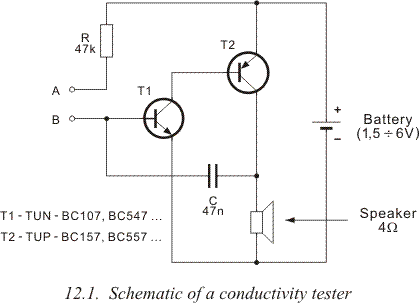 From
the equation above, it is clear that varying of the frequency is
possible by varying the resistor or capacitor value. Frequency rise is
achieved by lowering the resistance or capacitance of the circuit, and
vice versa, rising the values of the resistor or capacitor, lowers the
oscillator frequency. Active variation of the frequency base is
possible by replacing the resistor with a several hundred kiloohm
trimmer potentiometer. If such modification of the circuit was needed,
special care must be taken not to set the trimmer into it's lowest
position since this means zero resistance, and that could burn the
transistors. To avoid unnecessary care and further complicating the
operation of this straightforward device, low value resistor could be
connected to the trimmer in series. This resistor would act as a
protection for transistors inside of the circuit since it facilitates a
minimum resistance, and thus doesn't leave transistors bare in the
frying pan when the trimmer is in it's lowest position. From
the equation above, it is clear that varying of the frequency is
possible by varying the resistor or capacitor value. Frequency rise is
achieved by lowering the resistance or capacitance of the circuit, and
vice versa, rising the values of the resistor or capacitor, lowers the
oscillator frequency. Active variation of the frequency base is
possible by replacing the resistor with a several hundred kiloohm
trimmer potentiometer. If such modification of the circuit was needed,
special care must be taken not to set the trimmer into it's lowest
position since this means zero resistance, and that could burn the
transistors. To avoid unnecessary care and further complicating the
operation of this straightforward device, low value resistor could be
connected to the trimmer in series. This resistor would act as a
protection for transistors inside of the circuit since it facilitates a
minimum resistance, and thus doesn't leave transistors bare in the
frying pan when the trimmer is in it's lowest position.
In this
example we used an 1.5V battery for supply, but it is possible to plug
this instrument on any battery between 1.5V and 9V.
Current flowing through the component that is being tested is lower
than I=U/R, where U is the voltage of the supply battery, and R is the
resistance of the resistor in the base circuit. In our example, these
values are U=1,5 V i R=47 kW, which means that current flow is I=32
micro amperes, which is very low, so tested component is safe from harm
from this device.
Oscillator's printed board design is on 12.2. This is viewed from the
copper plated side of the board, components are placed on the other
side, so their positions are marked in dotted lines. Component side of
the board is on 12.2.
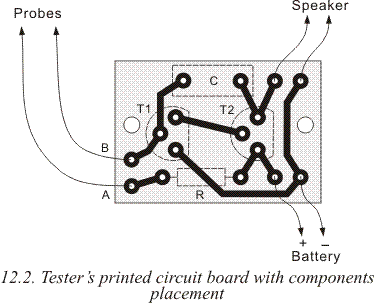 Printed
board, battery and the speaker are placed in a small box, as shown on
12.3. Miniature speaker is fixed to the upper pane of the box using two
wood screws. It is connected to the circuit board using two threaded
isolated wires. Same wires are used for all other connections as well.
Battery is connected to the board using these wires, for example. In
our example, wires are soldered directly to the poles of the battery,
and the board fixed inside of the box using wood screws and two
rectangular wooden pads glued to the bottom of the box, leaving just
enough space to squeeze the battery in. These are not proper solutions,
they are cheap “hacks” used when other options are limited. But these
are functional for people who always have their trusty soldering iron
at hand. What would be a proper solution? Buying a battery holder (with
enough battery slots as needed) or battery clips (for those square 9V
batteries) would simplify the process of changing the battery, although
this circuit is very low in power consumption. Other thing is plastic
or metal mounts for boards, these are pretty cheap and you should keep
them at hand in your “junk box” when experimenting with electronics. Printed
board, battery and the speaker are placed in a small box, as shown on
12.3. Miniature speaker is fixed to the upper pane of the box using two
wood screws. It is connected to the circuit board using two threaded
isolated wires. Same wires are used for all other connections as well.
Battery is connected to the board using these wires, for example. In
our example, wires are soldered directly to the poles of the battery,
and the board fixed inside of the box using wood screws and two
rectangular wooden pads glued to the bottom of the box, leaving just
enough space to squeeze the battery in. These are not proper solutions,
they are cheap “hacks” used when other options are limited. But these
are functional for people who always have their trusty soldering iron
at hand. What would be a proper solution? Buying a battery holder (with
enough battery slots as needed) or battery clips (for those square 9V
batteries) would simplify the process of changing the battery, although
this circuit is very low in power consumption. Other thing is plastic
or metal mounts for boards, these are pretty cheap and you should keep
them at hand in your “junk box” when experimenting with electronics.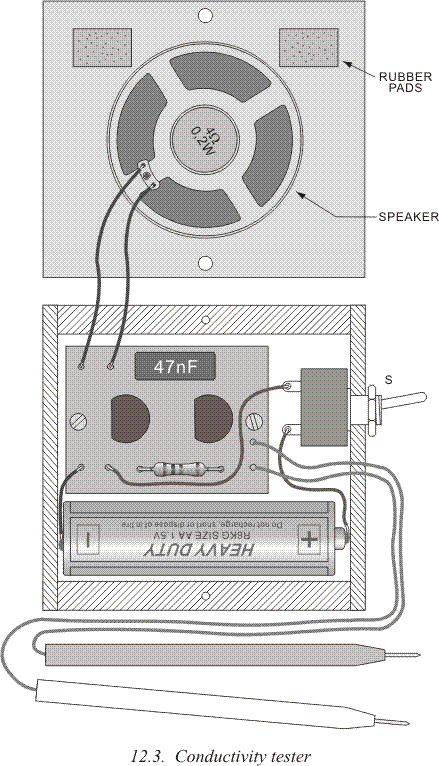 On
the front side of the box, we drilled two holes, one for the switch and
the other for wires which hold probes on their ends. Probes are cheap
components and come in various shapes and sizes with various purposes
in mind. Since we've been applying dirty methods, like soldering the
battery, there is no reason why we should back from building our own
probes now. Any old marker-pen will do, just slip thicker copper wire
through it's center, and sand/grind/cut protruding ends into a pointy
tip. It is advisable to make probes in different colors, red and black
are dominant standards for distinguishing them. Positive probe (red) is
connected to point A, and negative one (black) is connected to the
point B. You could use alligator clips instead of probes, for example,
this would leave your hands free for other purposes, but for some
precise testing of the on-board components, go with the more precise
probes we already mentioned. On
the front side of the box, we drilled two holes, one for the switch and
the other for wires which hold probes on their ends. Probes are cheap
components and come in various shapes and sizes with various purposes
in mind. Since we've been applying dirty methods, like soldering the
battery, there is no reason why we should back from building our own
probes now. Any old marker-pen will do, just slip thicker copper wire
through it's center, and sand/grind/cut protruding ends into a pointy
tip. It is advisable to make probes in different colors, red and black
are dominant standards for distinguishing them. Positive probe (red) is
connected to point A, and negative one (black) is connected to the
point B. You could use alligator clips instead of probes, for example,
this would leave your hands free for other purposes, but for some
precise testing of the on-board components, go with the more precise
probes we already mentioned.
Give your new instrument the initial
self-test (battery might be empty, or some other unexpected thing
happened) by connecting the probe tips together. If sound is heard from
the speaker, everything is fine and ready for work.
Ok, everything is working, now you want to play with your new toy.
Check, for example, conductivity of your own body. Hold probe tips
between thumb and index finger of your left and right hand. What you
hear is a sound whose level and especially frequency depend on your
skin moistness. Wow, now instrument could be used as a very crude an
inaccurate lie detector. This probably wouldn't be accepted in a court
of law, but may be an interesting game you play on your friends.
“Suspect” holds in his/hers hands probes which could be made of a metal
pipe for this occasion. Pipe should be wide enough so that a large
portion of palm surface is actually in contact with metal. When the
suspect starts dodging questions or lying, his palms start sweating
more than usual, and the tone produced by our “lie detector” is higher
than usual.
12.1
Semiconductors check
To
test diodes using this circuit, we fall back to the diode theory of
operation: when anode is positive comparing to the cathode (red probe
on anode, black on cathode), whole diode acts as a low value resistor,
which means that speaker sound is higher than usual. On the other hand,
in the opposite direction, sound is lower because in that direction
diode acts as a high value resistor. Testing process is shown on 12.4.
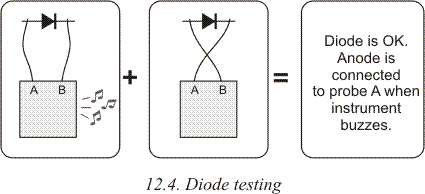 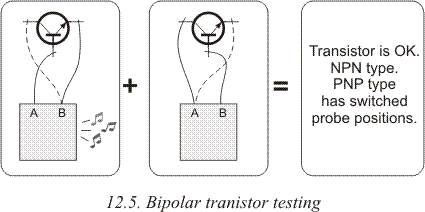
DC transistor acts in the same fashion as two connected diodes (11.4a).
If both diodes are functional, transistor is functional as well as
shown on 12.5. As you can see, probe A is connected to the base, and
then probe B is connected first to the emitter, and then to the
collector. In both cases, if the transistor is ok, “music” would have
been heard. We then switch probe connections, A goes where B was
connected to and vice versa, if there is no music now, everything is in
order. So, transistor is faulty if speaker remains silent in the first
two measurements, or if it “plays” in one of the second two
measurements.
FET testing is done in similar fashion as testing the bipolar transistors, which is shown on 12.6.
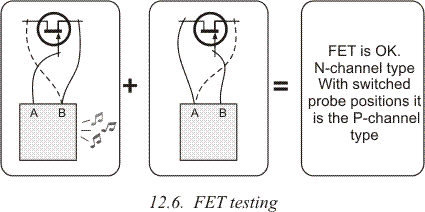 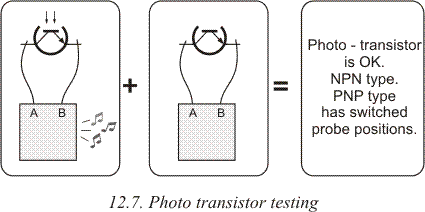
One principle that is applicable when testing the photo resistors,
photo transistors and diodes is NL-NM (or, No Light – No Music). Probe
A is connected to the collector of the transistor, or diode's anode or
one side of the photo resistor, and the other one is connected to
transistor's emitter or diode's cathode or the other resistor's side
and some kind of sound should be heard from the speaker. If this
continues when the component is shadowed using your palm, everything is
in functional order. We displayed graphically the method of testing
photo sensitive components on 12.7.
12.2
Checking other components
Many other components may be tested using this instrument. Base rule
is: if component is intended to conduct electricity, sound will be
heard. This is the case with resistors, coils, transformers, fuses,
closed switches. If component doesn't conduct electricity, like
capacitors, or open switches, or two copper wires on the circuit board
which shouldn't be connected, then music would have not been heard.
When testing different resistors, it is apparent that different
resistance values give different output sound. So with some experience
using this instrument on various resistors it will be possible to tell
the resistance of the resistor in question from only the generated
sound. This may be easier and more accurately done using regular
ohmmeter on your multimeter, but your nerd level will certainly rise
sky high if you are able to tell resistor's value from bare sound.
Components which have coils in them, like different electro motors,
headphones, speakers, transformers and such conduct electricity, so
absence of sound while testing tells of some coil connection failure.
With transformers with several secondary coils there is a possibility
to find beginning and the end of each of them. And from the sound
frequency one is possible to tell which coil is primary and which is
secondary.
Functional capacitor will generate no music. An exception are
electrolithic and block capacitors, especially the larger ones. Tone
generated by connecting these capacitors to the instrument will change
in level and frequency and fade until completely off when capacitor is
discharged. Length of playing depends on the capacitance of the
component, where higher values give longer sound time, which allows for
a crude approximation of the component's capacitance.
|
 From
the equation above, it is clear that varying of the frequency is
possible by varying the resistor or capacitor value. Frequency rise is
achieved by lowering the resistance or capacitance of the circuit, and
vice versa, rising the values of the resistor or capacitor, lowers the
oscillator frequency. Active variation of the frequency base is
possible by replacing the resistor with a several hundred kiloohm
trimmer potentiometer. If such modification of the circuit was needed,
special care must be taken not to set the trimmer into it's lowest
position since this means zero resistance, and that could burn the
transistors. To avoid unnecessary care and further complicating the
operation of this straightforward device, low value resistor could be
connected to the trimmer in series. This resistor would act as a
protection for transistors inside of the circuit since it facilitates a
minimum resistance, and thus doesn't leave transistors bare in the
frying pan when the trimmer is in it's lowest position.
From
the equation above, it is clear that varying of the frequency is
possible by varying the resistor or capacitor value. Frequency rise is
achieved by lowering the resistance or capacitance of the circuit, and
vice versa, rising the values of the resistor or capacitor, lowers the
oscillator frequency. Active variation of the frequency base is
possible by replacing the resistor with a several hundred kiloohm
trimmer potentiometer. If such modification of the circuit was needed,
special care must be taken not to set the trimmer into it's lowest
position since this means zero resistance, and that could burn the
transistors. To avoid unnecessary care and further complicating the
operation of this straightforward device, low value resistor could be
connected to the trimmer in series. This resistor would act as a
protection for transistors inside of the circuit since it facilitates a
minimum resistance, and thus doesn't leave transistors bare in the
frying pan when the trimmer is in it's lowest position. Printed
board, battery and the speaker are placed in a small box, as shown on
12.3. Miniature speaker is fixed to the upper pane of the box using two
wood screws. It is connected to the circuit board using two threaded
isolated wires. Same wires are used for all other connections as well.
Battery is connected to the board using these wires, for example. In
our example, wires are soldered directly to the poles of the battery,
and the board fixed inside of the box using wood screws and two
rectangular wooden pads glued to the bottom of the box, leaving just
enough space to squeeze the battery in. These are not proper solutions,
they are cheap “hacks” used when other options are limited. But these
are functional for people who always have their trusty soldering iron
at hand. What would be a proper solution? Buying a battery holder (with
enough battery slots as needed) or battery clips (for those square 9V
batteries) would simplify the process of changing the battery, although
this circuit is very low in power consumption. Other thing is plastic
or metal mounts for boards, these are pretty cheap and you should keep
them at hand in your “junk box” when experimenting with electronics.
Printed
board, battery and the speaker are placed in a small box, as shown on
12.3. Miniature speaker is fixed to the upper pane of the box using two
wood screws. It is connected to the circuit board using two threaded
isolated wires. Same wires are used for all other connections as well.
Battery is connected to the board using these wires, for example. In
our example, wires are soldered directly to the poles of the battery,
and the board fixed inside of the box using wood screws and two
rectangular wooden pads glued to the bottom of the box, leaving just
enough space to squeeze the battery in. These are not proper solutions,
they are cheap “hacks” used when other options are limited. But these
are functional for people who always have their trusty soldering iron
at hand. What would be a proper solution? Buying a battery holder (with
enough battery slots as needed) or battery clips (for those square 9V
batteries) would simplify the process of changing the battery, although
this circuit is very low in power consumption. Other thing is plastic
or metal mounts for boards, these are pretty cheap and you should keep
them at hand in your “junk box” when experimenting with electronics. On
the front side of the box, we drilled two holes, one for the switch and
the other for wires which hold probes on their ends. Probes are cheap
components and come in various shapes and sizes with various purposes
in mind. Since we've been applying dirty methods, like soldering the
battery, there is no reason why we should back from building our own
probes now. Any old marker-pen will do, just slip thicker copper wire
through it's center, and sand/grind/cut protruding ends into a pointy
tip. It is advisable to make probes in different colors, red and black
are dominant standards for distinguishing them. Positive probe (red) is
connected to point A, and negative one (black) is connected to the
point B. You could use alligator clips instead of probes, for example,
this would leave your hands free for other purposes, but for some
precise testing of the on-board components, go with the more precise
probes we already mentioned.
On
the front side of the box, we drilled two holes, one for the switch and
the other for wires which hold probes on their ends. Probes are cheap
components and come in various shapes and sizes with various purposes
in mind. Since we've been applying dirty methods, like soldering the
battery, there is no reason why we should back from building our own
probes now. Any old marker-pen will do, just slip thicker copper wire
through it's center, and sand/grind/cut protruding ends into a pointy
tip. It is advisable to make probes in different colors, red and black
are dominant standards for distinguishing them. Positive probe (red) is
connected to point A, and negative one (black) is connected to the
point B. You could use alligator clips instead of probes, for example,
this would leave your hands free for other purposes, but for some
precise testing of the on-board components, go with the more precise
probes we already mentioned.


